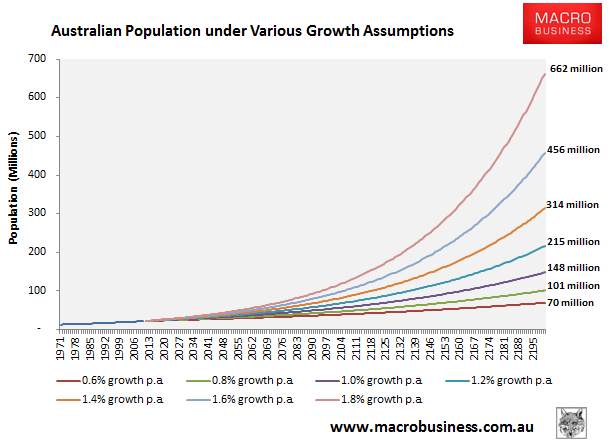
Michael Pascoe has written a curious piece in the Fairfax dailies supporting a Big Australia “at least until we boomers shuffle off”, while also lamenting the woeful state of Australia’s infrastructure:
…one of the very few pleasing aspects of Australian politics over the past couple of years is that population growth has quietly slipped off the radar. Both sides know that our aging demographic profile demands strong population growth at least until we boomers shuffle off – if we ever do…
The usual Doomsayers who don’t understand our country’s untapped capacities and our own resourcefulness had a whinge about sustainability, but the rest of us just kept growing regardless...
At our present population growth rate of 1.8 per cent, the wonder of compound interest means there will be nearly 10 per cent more of us in five years…
It’s an amazing task to grasp and a wonderful opportunity for business – and it’s a more amazing challenge for our politicians…
To make our growing Australia as enjoyable, functioning and successful as it should be and needs to be, a much bolder and broader vision is required. Instead, we’re getting shrinkage…
Meeting our population challenge requires investment, sound investment that will pay handsome dividends that justify borrowing.
I couldn’t help but feel frustrated by Pascoe’s arguments.
While his comments around well-targeted infrastructure are sound, irrespective of the level of population growth, his labeling of anyone critical of rapid population growth (immigration) as a “doomsayer” is both childish and ignores a number of inconvenient truths.
First, Pascoe’s claim that strong immigration is required to see-off the demographic challenge from the retirement of the baby boomers does not hold water.
At best, all immigration can do is delay, not avoid, population ageing, thereby pushing the problem on to future generations. Indeed, the Productivity Commission’s submission to the former Minister for Population confirmed that immigration’s effect on Australia’s age structure is only modest and temporary, contradicting Pascoe’s claim about demographic benefits:
…several studies, including some undertaken by the Commission, indicate that policy-induced changes to Australia’s population are unlikely to significantly affect the ageing trends.
Improvements in longevity are the major cause of population ageing over the long run. In recent projections, Commission researchers estimated that an increase in the long-run total fertility rate from 1.85 to 2.10 births per woman — even if it could be achieved — would be associated with only a 1.1 percentage point reduction in the proportion of people aged over 65 by 2051.
Similarly, substantial increases in the level of net overseas migration would have only modest effects on population ageing and the impacts would be temporary, since immigrants themselves age. The Commission has estimated that an increase in annual net migration from 150 000 to 300 000 would lower the proportion of those aged 65 or over by less than 3 percentage points by 2044-45. As an illustration ofthe challenge, the Commission showed that delaying an increase in the dependency ratio by 40 years would require a net migration-to-population ratio of 3 per cent per year, leading to a population of around 85 million by 2044-45.
It follows that, rather than seeking to mitigate the ageing of the population, policy should seek to influence the potential economic and other impacts.
Further, while the current population growth rate of 1.8% seems fairly benign, due to the powers of compounding, such a rate of growth is clearly unsustainable over a longer time frame (see next chart). Hence, the issue of an ageing population would need to be addressed at some point, irrespective of the level of immigration.

Second, Pascoe’s comment that us doomsayers do not understand “our country’s untapped capacities and our own resourcefulness” and that we are having “a whinge about sustainability” is not particularly helpful. What us realists do understand is that Australia pays its way in the world predominantly through selling its fixed endowment of mineral resources. More people means less resources per capita. It also means that we must sell-off our resources at a faster rate just to maintain our standard of living. Viewed in this light, how is a Big Australia a sensible goal and in the bests interests of the pre-existing population?
Of course, Pascoe’s comment that a Big Australia is a “wonderful opportunity for business” is spot on. In fact, it is big business and the owners of capital that are the primary beneficiaries of Australia’s population ponzi.
As we all know, Australia is ruled by duopolies and oligopolies, which see a rising population as an easy way of selling more goods and services. Big business also receives, through immigration, access to lower cost workers. And there’s less need to become more efficient when your customer base is growing inexorably. Rather, just sit back and watch the profits flow.
Take, for example, Australia’s banks, which get the double bonus of not just having more consumers to sell debt to, but also extra demand for housing, which helps to support house prices and their loan collateral, especially given the urban consolidation policies operated by Australia’s states.
However, while the big end of town is a clear winner from rapid population growth, it doesn’t wear many of the costs. That is borne by you and I.
It is the general public that must wear the increasing pressures on the pre-existing (already strained) stock of infrastructure and housing, which reduces productivity and living standards unless costly new investments are made (e.g. desalination plants), which also must be paid for by us.
And it is the broader economy that can suffer as investment to support the growing population crowds-out productive investment and capital deepening, as explained recently by Dr Katherine Betts from the Monash University Centre for Population and Urban Research:
The Productivity Commission report on ageing points out that the infrastructure spending needed to manage population growth over the next 50 years will be five times the total that was needed over the last 50 years. This investment in capital widening must seriously weaken Australia’s capacity to invest in the capital deepening that would boost productivity.
Despite this, Treasury continues to emphasise its ‘three Ps’: population, participation and productivity. While Treasury treats these three variables as if they were independent some commentators argue that population growth has a positive effect on productivity. But there is a contrary argument. Population growth imposes pressures on infrastructure and adds to congestion; in so doing it depresses productivity.
International comparisons show that there is no association between population growth and growth in per capita GDP. This is not surprising as comparative data on 32 OECD countries show no positive association between population growth and growth in labour productivity…
Assertions that immigration-fuelled population growth will boost productivity remain conjectural. There is no empirical evidence that such growth in an advanced economy increases productivity.
As argued many times before, while I believe that Australia could probably support a substantially larger population with improved policy settings and investment, like many Australians, I don’t hold much faith in our political class or policy making processes, which have time and again proven to be deficient in providing adequately for the pre-existing population (let also tens of millions more people), or that a substantially larger population would improve living standards anyway.
The fact is, a Big Australia has been thrust upon the electorate first by the Howard Government who, despite talking tough on asylum seekers, stealthily increased Australia’s immigration program in the mid-2000s. This approach gained bipartisan support, with the Rudd/Gillard Governments embracing high immigration (remember Rudd’s “Big Australia” boast), and now both sides of politics want it maintained (actually, Opposition Leader, Bill Shorten, has argued for a significant increase in immigration intake).
There has been no national discussion on Australia’s population policy and no national plan released. We citizens have been treated like mugs, effectively told to shut-up and labelled a doomsayer, racist or xenophobic whenever legitimate concerns are raised about the downsides of such strong population growth.
Pascoe’s rant is yet another commentary along these lines. But what he offers is no economic plan. But rather a way of back-filling previous booms when we over-fattened ourselves; of maintaining baby boomers’ entitlements and inflated asset values while the rest of us slide backwards without anyone really noticing.

